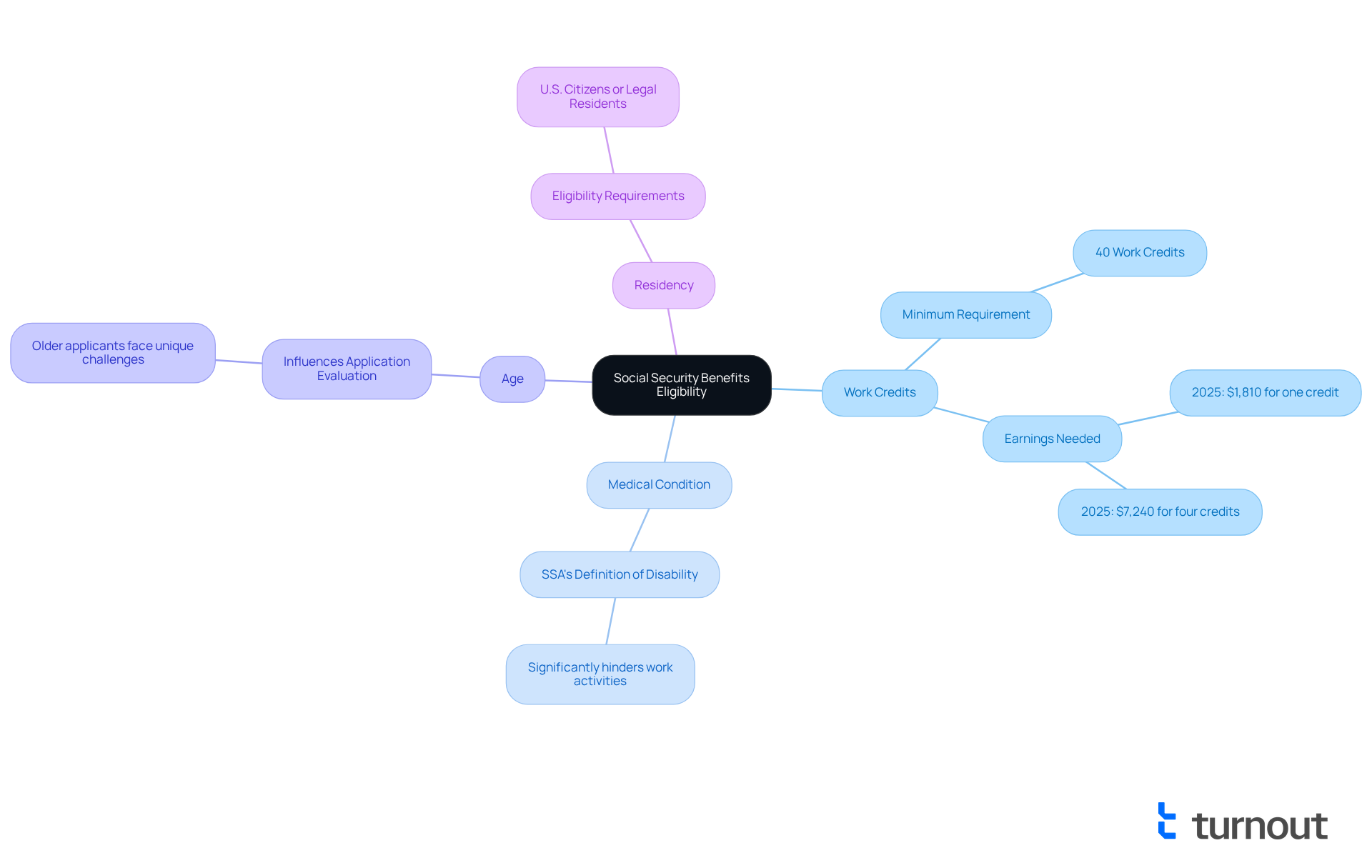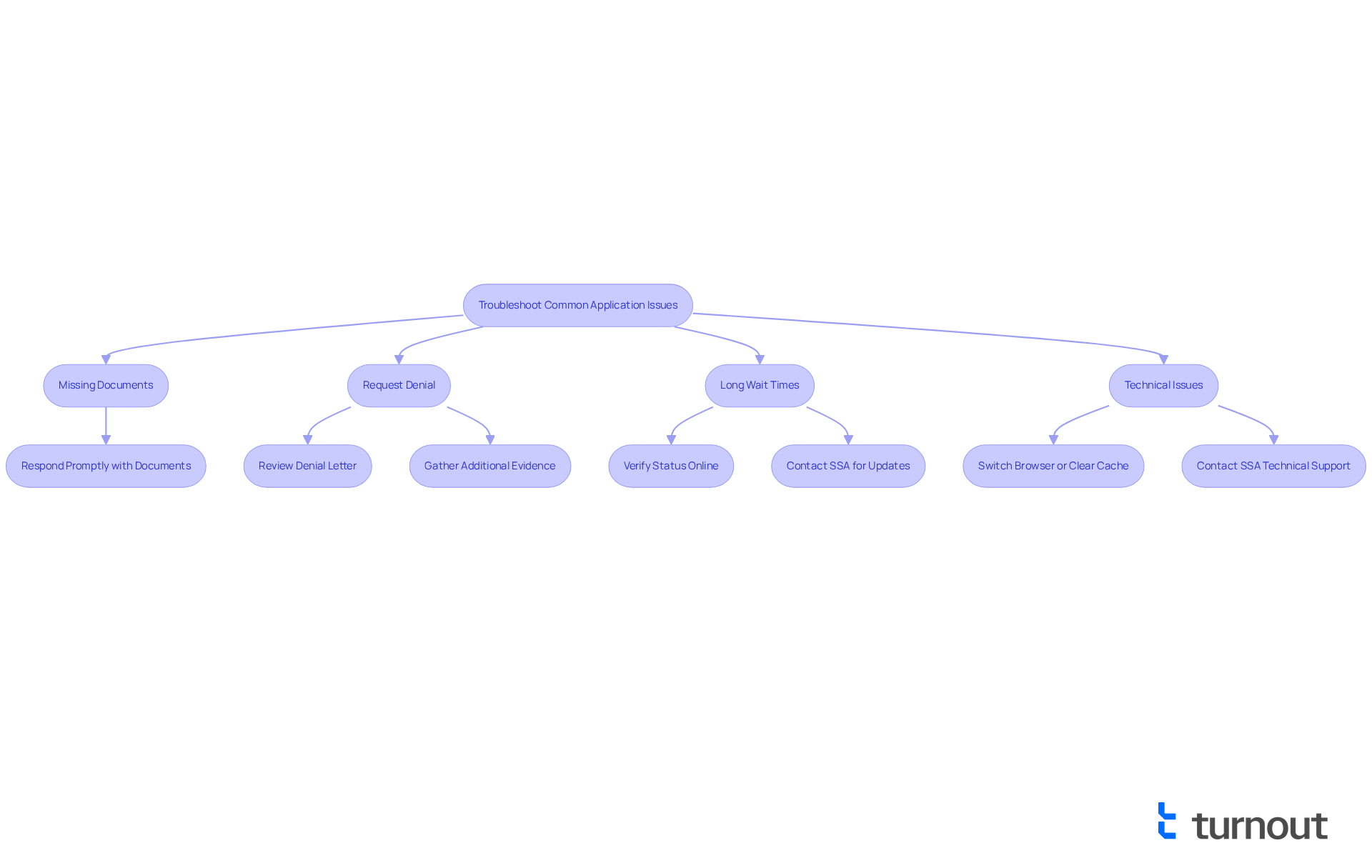Overview
Navigating the Social Security process in Colorado Springs can feel overwhelming, but we're here to help. This article serves as your comprehensive guide, outlining four essential steps to ease your journey:
- Understanding eligibility criteria
- Collecting required documentation
- Following the application submission process
- Troubleshooting common issues
We understand that gathering the necessary documents can be daunting. That's why we emphasize the importance of having everything ready before you start. Knowing how to appeal a denial is also crucial, as it empowers you to take control of your situation.
Each step is supported by detailed explanations and practical tips, ensuring you're well-prepared to access the benefits you deserve. Remember, you're not alone in this journey. With the right information and support, you can successfully navigate the process and secure your benefits.
Introduction
Navigating the Social Security system can often feel like an uphill battle, especially for those seeking benefits in Colorado Springs. We understand that the process can be overwhelming. Understanding the eligibility criteria and the documentation required is essential for a successful application process. Many applicants face a myriad of challenges, from missing paperwork to lengthy wait times. It's common to feel frustrated and unsure.
How can individuals ensure they are fully prepared to tackle these hurdles and secure the benefits they deserve? We're here to help you through this journey.
Understand Social Security Benefits Eligibility Criteria
Navigating the path to Social Security benefits can feel overwhelming, but understanding the eligibility criteria is a vital first step. Here’s what you need to know:
-
Work Credits: To qualify, you need a minimum of 40 work credits, with at least 20 earned in the last 10 years. In 2025, earning at least $1,810 for one credit will be essential. This highlights the importance of maintaining consistent employment.
-
Medical Condition: It’s crucial to have a medical condition that aligns with the Social Security Administration's (SSA) definition of disability. This means your condition must significantly hinder your ability to perform essential work activities.
-
Age: While your age doesn’t directly affect your eligibility for disability benefits, it can influence how your application is evaluated, particularly if you are older and facing unique workforce challenges.
-
Residency: Remember, only U.S. citizens or legal residents can qualify for these benefits.
Recent changes, such as the increase in work credit requirements, may affect eligibility for some individuals. For instance, the SSA has noted that approximately 200,000 new requests for benefits have been processed since the Fairness Act was implemented. This underscores the ongoing need for clarity regarding these requirements.
As you explore your options, it’s important to know that spousal benefits may also be available, even if you do not qualify for your own benefits. The highest spousal advantage can be 50% of your partner's financial assistance benefit, providing significant support.
For more detailed information, we encourage you to visit the SSA's official website to review the specific conditions and requirements. Remember, you are not alone in this journey, and we’re here to help you every step of the way.

Collect Required Documentation for Your Application
Before you send your application for government benefits, it’s crucial to gather the required documentation. This will help simplify the process and prevent any delays. We understand that this can feel overwhelming, so here’s what you need:
- Proof of Identity: Acceptable forms include a U.S. driver's license, state-issued ID, or passport. Please note that starting March 31, 2025, you will need to visit a government office in person for identity verification.
- Social Security Number: If you don’t have your card, a record of your number will be sufficient.
- Birth Certificate: An original or certified copy is necessary to verify your age.
- Medical Records: Obtain documentation from your healthcare provider that details your medical condition and how it affects your ability to work.
- Work History: Prepare a list of your employers for the past 15 years, including their addresses and phone numbers.
- Income Information: Collect recent pay stubs, tax returns, or other proof of income.
It's important to know that only about 30% of candidates have all necessary documentation ready at the time of submission, which can lead to delays. By ensuring you have these documents organized, you can significantly improve your chances of a smooth submission process. Additionally, consider setting up a 'my Benefits' account, as it helps prevent fraud and simplifies your application process. Remember to keep copies of all documents you submit for your records.
For more information on specific documentation requirements, please refer to the Administration's documentation guide. You are not alone in this journey; we're here to help you navigate the process with confidence.

Follow the Application Submission Process
Once you have gathered all the necessary documentation, we understand that submitting your application can feel overwhelming. Here are some steps to help you through the process:
- Select Your Submission Method: You can apply online through the SSA website, by phone, or in person at your local government office. Choose the method that feels most comfortable for you.
- Complete the Form: If you’re applying online, take a moment to create a 'my Social Security' account to fill out the form. If you prefer to apply by phone, don’t hesitate to call 1-800-772-1213 to schedule an appointment.
- Submit Your Documents: If you’re applying in person, please remember to bring all your documents. For online or phone applications, you may need to mail your documents to the SSA, and that’s perfectly fine.
- Keep Track of Your Submission: After you submit your application, you can check the status of your request online or by calling the SSA. We want you to stay informed every step of the way.
For more information on the submission process, please visit the SSA's submission page. Remember, you're not alone in this journey; we're here to help.

Troubleshoot Common Application Issues
Navigating the public assistance enrollment process can be challenging, and we understand how exasperating it can feel. Here are some supportive troubleshooting tips to help you overcome common obstacles:
- Missing Documents: If the Social Security Administration (SSA) requests additional information, it’s important to respond promptly with the necessary documents. Delays in submission can lead to prolonged processing times, which can be frustrating.
- Request Denial: Should your request be denied, take a moment to carefully review the denial letter. Understanding the specific reasons—such as insufficient medical evidence or not meeting eligibility criteria—can empower you. Remember, you have the right to appeal the decision by following the instructions in the letter. A recent audit revealed that the SSA discovered $72 billion in improper payments, highlighting the importance of ensuring your submission is complete and accurate.
- Long Wait Times: Many applicants experience long wait times, with some facing delays of over eight months for a response. If you find yourself in this situation, it’s a good idea to verify your status online or reach out to the SSA for updates. As one advocate noted, "Understanding the reasons behind delays can help you manage your expectations and plan your next steps."
- Technical Issues: Encountering technical difficulties while applying online? Consider switching to a different browser or clearing your cache. If issues persist, don’t hesitate to reach out to SSA technical support for assistance.
Real-life examples remind us of the importance of persistence. For instance, one applicant successfully appealed a denial by gathering additional medical documentation that demonstrated their disability's impact on daily life. Advocates emphasize that understanding the reasons behind denials is crucial for crafting a strong appeal. As one supporter mentioned, "Being proactive and knowledgeable can greatly enhance your likelihood of success in the submission process."
By following these tips, you can navigate the complexities of the Social Security application process more effectively and increase your chances of receiving the benefits you deserve. Remember, you are not alone in this journey. For more information on troubleshooting, visit the SSA's FAQ page.

Conclusion
Navigating the Social Security system in Colorado Springs can feel overwhelming. We understand that the process may seem daunting, but knowing the essential steps can make a significant difference. This article outlines a clear pathway to securing benefits, emphasizing the importance of:
- Understanding eligibility criteria
- Gathering necessary documentation
- Following the submission process
- Troubleshooting common issues
Key points discussed include:
- The vital work credits required for eligibility
- The significance of medical documentation
- The various methods for submitting applications
Additionally, practical tips for overcoming potential obstacles, such as missing documents or application denials, empower you to take charge of your journey.
Ultimately, the message is clear: being well-informed and prepared is crucial when applying for Social Security benefits. By taking the time to understand the requirements and utilizing available resources, you can navigate the system more effectively. Remember, staying proactive and persistent can make a significant difference in achieving a successful outcome. You're not alone in this journey; we're here to help.
Frequently Asked Questions
What are the work credit requirements to qualify for Social Security benefits?
To qualify for Social Security benefits, you need a minimum of 40 work credits, with at least 20 earned in the last 10 years. In 2025, earning at least $1,810 for one credit will be essential.
What medical condition is required for Social Security disability benefits?
You must have a medical condition that aligns with the Social Security Administration's (SSA) definition of disability, meaning it must significantly hinder your ability to perform essential work activities.
Does age affect eligibility for Social Security disability benefits?
While your age does not directly affect your eligibility for disability benefits, it can influence how your application is evaluated, especially if you are older and facing unique workforce challenges.
Who is eligible to receive Social Security benefits based on residency?
Only U.S. citizens or legal residents can qualify for Social Security benefits.
Have there been any recent changes to Social Security eligibility requirements?
Yes, recent changes, such as the increase in work credit requirements, may affect eligibility for some individuals. The SSA has noted that approximately 200,000 new requests for benefits have been processed since the Fairness Act was implemented.
Are spousal benefits available if I do not qualify for my own Social Security benefits?
Yes, spousal benefits may be available even if you do not qualify for your own benefits. The highest spousal advantage can be 50% of your partner's financial assistance benefit.
Where can I find more detailed information about Social Security benefits?
For more detailed information, it is encouraged to visit the SSA's official website to review the specific conditions and requirements.




